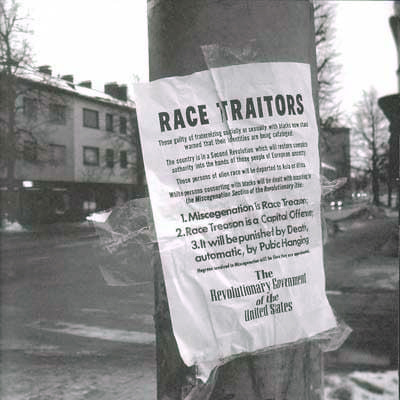of The Turner Diaries, 8
Although the Whites are badly outnumbered in only a few mixed neighborhoods, they seem to have lost the feeling of identity and unity which the Blacks and Chicanos still have.
Most of all, though, many of them seem to be convinced that any effort at self-defense would be “racist,” and they fear being thought of as racists—or thinking of themselves that way—more than they fear death. Even when gangs of Blacks took their children away or raped their women before their eyes, they offered no significant resistance. Really sick!
It’s hard for me to feel sorry for Whites who won’t even try to protect themselves, and it’s even harder for me to understand why we should take chances and knock ourselves out to save such brainwashed scum from the fate they richly deserve. And yet it is in the mixed areas that we’re having the most trouble and taking the most chances! [page 152]
______ 卐 ______
But about 10 per cent of them are not from the border areas at all. They are White volunteers who have deliberately crossed over to join our fight. Some have come from as far as the East Coast, whole families as well as young men, who made their decision as soon as it became apparent to the country that our revolution has indeed established a foothold here. [page 156]
______ 卐 ______
And even if we could hang that many people, there would be no good reason for it; most of that 10 per cent are really no worse than most of the other 90 per cent. They have been brainwashed; they are weak and selfish; they have no sense of racial loyalty—but the same things are true of most people these days. People are what they have become, and we have to accept that—as a starting point.
Actually, it has been true all through history that only small portions of a population are either good or evil. The great bulk are morally neutral—incapable of distinguishing absolute right from absolute wrong—and they take their cue from whoever is on top at the moment.
When good men are the rulers and the program-makers for a society, the population as a whole will reflect this, and people with no originality or moral sense of direction of their own will nevertheless fervently support the highest aims of their society. But when evil men rule, as has been the case in America for many years now, most of the population will wallow happily in degeneracy of the worst kind and will self-righteously parrot every filthy and destructive idea that they have been taught.
Most judges today, most teachers, actors, civic figures, etc., are not being consciously and deliberately evil, or even cynical, in following the lead of the Jews. They think of themselves as being “good citizens,” just as they would think of themselves if they were acting in a diametrically opposite way under the influence of good leaders.
Thus, there is no point in killing them all. This moral weakness will have to be bred out of the race over hundreds of generations. For now it is sufficient for us to eliminate the consciously evil portion of the population—plus a few hundred thousand of our morally crippled “good citizens” across the country, as an example to the rest.
The hanging of a few of the worst race-criminals in every neighborhood in America will help enormously in straightening out the majority of the population and reorienting their thinking. In fact, it will not only help, but it is absolutely necessary. The people require a strong psychological shock to break old habits of thought.
I understand all this, yet I must admit that I was troubled by some of the things I witnessed today.

When the arrests first started the public didn’t realize what was coming, and many citizens were cocky and abusive. I was present shortly before dawn when the soldiers dragged about a dozen young people out of a large house near one of the university campuses, and they, as well as their housemates who were not arrested, were screaming obscenities at our men and spitting on them. All but one of those arrested here were either Jews, Blacks, or mongrels of various sorts, and two of the loudest of them were immediately shot, while the others were herded into a marching column.
The last was a White girl, about 19, a bit flabby but still pretty. The shootings had calmed her down enough so that she was no longer screaming, “Racist pigs!” at the soldiers, but when the preparations for her hanging shortly thereafter awakened her to her own fate, she became hysterical. Informed that she was about to pay the price for defiling her race by living with a Black lover, the girl wailed, “But why me?”
As the rope was knotted around her neck, she blubbered out, “I was only doing what everyone else was. Why are you picking on me? It’s not fair! What about Helen? She was sleeping with him too.” At this last outcry before the girl’s breath was cut off forever, one of the other girls (presumably Helen) in the group of now-silent spectators on the lawn shrank back in terror.
Of course, no one answered the girl’s question, “Why me?” The answer is simply that her name happened to be on our list and Helen’s didn’t. There’s nothing “fair” about that—or unfair either. The girl who was hanged deserved what she got. Helen probably deserves the same fate—and she is undoubtedly suffering the torments of the damned now, in fear that she eventually will be found out and forced to pay the price her friend did.
This little episode has taught me something about political terror. Its very arbitrariness and unpredictability are important aspects of its effectiveness. There are a great many people in Helen’s situation, whose fear that lightning may strike them at any moment will keep them walking on eggs.
The melancholy aspect of the episode is epitomized in the girl’s lament, “I was only doing what everyone else was.” That is a bit of an exaggeration, but it is true enough that had others not set a bad example for her the girl probably would not have become a race-criminal. She paid as much for the sins of others as for her own. Now I realize more than ever before how essential it is that we instill in all our people a new moral basis, a new set of fundamental values, so that they will no longer be morally adrift like that unfortunate girl was—and like the great majority of Americans today are.
This total lack of any healthy or natural morality was brought home to me again just before noon. We were hanging a group of about 40 land developers and real estate brokers outside the offices of the Los Angeles County Fair Housing Association. They had all participated in a special program which made lower mortgage rates available for racially mixed families buying homes in predominantly White neighborhoods. One of the realtors was a sturdy, handsome fellow of about 35 with a blond crew cut. He was vehemently defending himself: “Hell, I never agreed with any of this race-mixing crap. It makes me sick to my stomach to see these mixed families with their mongrel brats. But a man has to earn a living. I was told by the head building inspector in the county that it would be a lot easier to avoid building-code violations for those realtors who went along with the special mortgage program.”
Without realizing it, he was telling us that a bigger income came before racial loyalty in his set of values—something which is unfortunately true also of a great many who were not hanged today. Well, he made his choice freely, and he hardly deserves any sympathy. [pages 166-168]
 Yesterday and the day before yesterday, I was watching a few clips on YouTube of Ridley Scott’s final cuts of Blade Runner. I saw the original one on the big screen in 1982 at the old Cine Tlalpan (there are almost no white people in Tlalpan, but I distinctly remember that the day I watched the film, a young, blond woman had gone to that theatre alone).
Yesterday and the day before yesterday, I was watching a few clips on YouTube of Ridley Scott’s final cuts of Blade Runner. I saw the original one on the big screen in 1982 at the old Cine Tlalpan (there are almost no white people in Tlalpan, but I distinctly remember that the day I watched the film, a young, blond woman had gone to that theatre alone).







